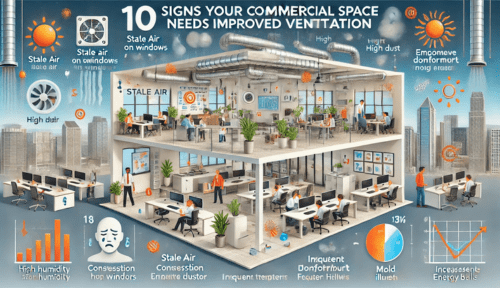Stuffy and Stale Air
One of the most common complaints in indoor environments is the presence of stuffy and stale air. This issue can arise from poor ventilation systems, lack of fresh air circulation, or even excessive indoor pollutants. The discomfort of breathing in stagnant air can lead to decreased productivity, concentration, and overall well-being.In workplaces or residential settings, stuffy and stale air can create an unpleasant atmosphere that may affect the health and comfort of individuals. It is crucial to address this issue promptly to ensure a conducive indoor environment that promotes good health and productivity. Implementing proper ventilation systems, regular air circulation, and investing in air purifiers or plants can significantly improve the quality of indoor air and mitigate the effects of stuffy and stale conditions.
Commercial Ventilation is essential to combat stuffy and stale indoor air. Poor ventilation, lack of fresh air, and pollutants can affect productivity and well-being. Proper ventilation systems, air circulation, and air purifiers can create a healthier indoor environment, improving overall quality of life.
Persistent Odors
One common issue that can arise in indoor environments is the presence of persistent odors. These unpleasant smells can linger and impact the overall atmosphere within a space. Whether it’s from cooking, pets, mold, or other sources, persistent odors can be bothersome and affect the comfort of those occupying the area. It’s essential to identify the root cause of these odors to effectively address and eliminate them, ensuring a fresh and pleasant indoor environment.Persistent odors not only create discomfort but can also be a sign of underlying issues that need attention. Ignoring persistent odors may lead to further problems, such as mold growth or poor indoor air quality. Addressing the source of the odors promptly is crucial to maintain a healthy and inviting indoor space for occupants. Regular cleaning, proper ventilation, and targeted odor removal techniques can help combat persistent odors and create a more enjoyable indoor environment.
Excessive Humidity
Excessive humidity levels within indoor environments can lead to a myriad of issues. The presence of high moisture content in the air can create a breeding ground for mold and mildew, which not only affects the aesthetics of the space but also poses health risks to occupants. Furthermore, excessive humidity can cause discomfort, making it harder for individuals to cool down and regulate body temperature effectively.In addition to the negative impact on health and comfort, excessive humidity can also damage building materials and furnishings over time. Wood can warp, paint can peel, and metal surfaces may rust more quickly in environments with high moisture levels. Therefore, it is crucial for property owners to address excessive humidity promptly to mitigate potential long-term structural damage and maintain a healthy indoor environment for occupants.
Mold or Mildew Growth
Mold and mildew growth within a workspace can signal underlying issues with ventilation and moisture control. These fungal developments not only pose health risks but also indicate a potential need for better air circulation and humidity regulation. Left unaddressed, mold and mildew can spread rapidly, affecting indoor air quality and employee well-being.In addition to health concerns, mold and mildew growth can also harm the physical infrastructure of a building. From discoloration of walls and ceilings to deterioration of materials, these fungi can compromise the structural integrity of the workspace. Identifying the root cause of mold and mildew growth is essential in implementing effective remediation strategies and preventing future occurrences.
Increased Allergy Symptoms
All too often, workplaces can unknowingly harbor allergens that trigger uncomfortable symptoms in employees. Sneezing, itchy eyes, and congestion can significantly impact productivity and overall well-being. These allergy symptoms may arise from a variety of sources present in the indoor environment, including dust mites, pollen, pet dander, and mold spores.Addressing the root cause of increased allergy symptoms in the workplace is crucial for creating a healthier and more comfortable atmosphere for employees. Regular cleaning, proper ventilation, and humidity control can help reduce allergens and improve indoor air quality. By taking proactive measures to minimize allergen exposure, businesses can promote a more conducive work environment and support the well-being of their staff.
Natural Home Solutions offer effective solutions for combating increased allergy symptoms in the workplace. By implementing regular cleaning, proper ventilation, and humidity control, businesses can create a healthier and more comfortable atmosphere for employees. Minimizing allergen exposure is key to promoting staff well-being.
Frequent Illness Among Employees
Employees at Natural Home Solutions have been experiencing a higher frequency of illnesses recently. This rise in sickness has caused concerns among both staff and management, leading to a thorough investigation into the possible causes. With productivity taking a hit due to increased absenteeism, it is crucial to identify and address the underlying issues promptly.The health and well-being of employees are paramount, and it is essential to create a work environment that promotes optimal health. By pinpointing the factors contributing to the frequent illnesses, such as poor indoor air quality or inadequate ventilation, measures can be taken to improve the overall working conditions. Addressing these concerns not only benefits the employees’ health but also enhances their productivity and satisfaction in the workplace.
Condensation on Windows
Condensation on windows can be a common issue in many buildings, causing concerns not just for aesthetics but also for potential damage and health implications. The presence of condensation indicates a difference in temperature between the interior and exterior of a space, leading to moisture buildup on the glass surface. This moisture can eventually lead to mold growth and decay of window frames if not addressed promptly.In addition to potential structural issues, condensation on windows can also impact the comfort levels within a building. The presence of water on windows can create a damp environment that may contribute to discomfort for occupants. Addressing the root cause of the temperature differential, improving ventilation, and considering the use of dehumidifiers are steps that can help mitigate condensation issues and create a healthier indoor environment.
Inconsistent Temperature Levels
One common issue that employees may encounter in the workplace is the inconsistency of temperature levels. This can lead to discomfort and dissatisfaction among staff members, impacting their productivity and overall well-being. In areas where the temperature fluctuates frequently, individuals may find it challenging to focus on their tasks, leading to decreased efficiency and morale.In addition, inconsistent temperature levels can also result in conflicts among employees who have varying comfort preferences. While some may feel too hot, others may feel too cold, creating tension and distractions in the work environment. This disparity in thermal comfort can disrupt teamwork and collaboration, hindering the overall dynamics of the workplace.
Noise or Poor Air Quality from HVAC System
If employees in your workplace have been complaining about respiratory issues, persistent headaches, or general discomfort, the culprit might be your HVAC system. Poor air quality from the HVAC system can lead to a variety of health problems among occupants in a building. Dust, allergens, and pollutants trapped within the system can circulate throughout the space, exacerbating respiratory conditions and allergies.Additionally, if you’ve noticed an increase in noise levels coming from your HVAC system, it could indicate underlying issues that need to be addressed. Excessive noise can be disruptive to employees and may be a sign of a malfunctioning system. Regular maintenance and professional inspections can help identify and resolve any air quality or noise problems associated with your HVAC system, ensuring a healthier and more comfortable work environment for all.
Difficulty Regulating Airflow
When airflow within a building becomes challenging to regulate, it often leads to discomfort and inefficiencies. Occupants may experience rooms that feel stuffy or too drafty, causing them to fiddle with thermostats in an attempt to find a suitable temperature. This constant adjustment not only disrupts productivity but also puts a strain on the heating, ventilation, and air conditioning (HVAC) system, potentially leading to higher energy bills and maintenance costs over time.Moreover, an HVAC system struggling to maintain consistent airflow can result in uneven temperatures throughout the building. Some areas may feel too warm while others remain chilly, creating an unpleasant environment for occupants. As a consequence, individuals may resort to using additional heating or cooling devices, further exacerbating the issue of energy wastage and escalating utility expenses for the company.

